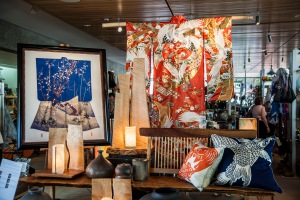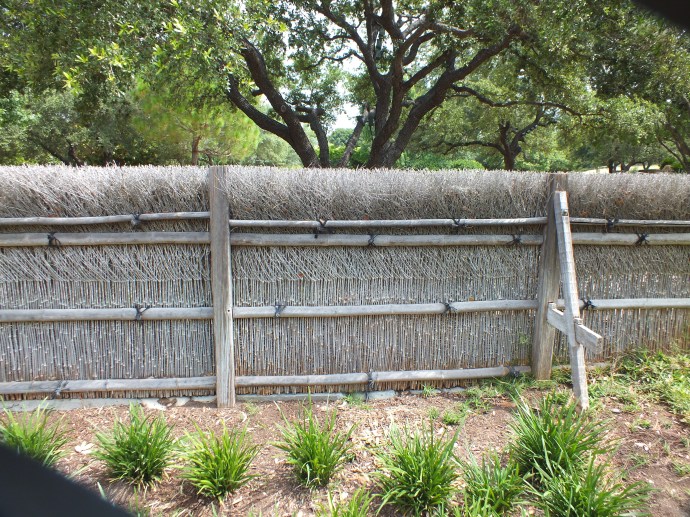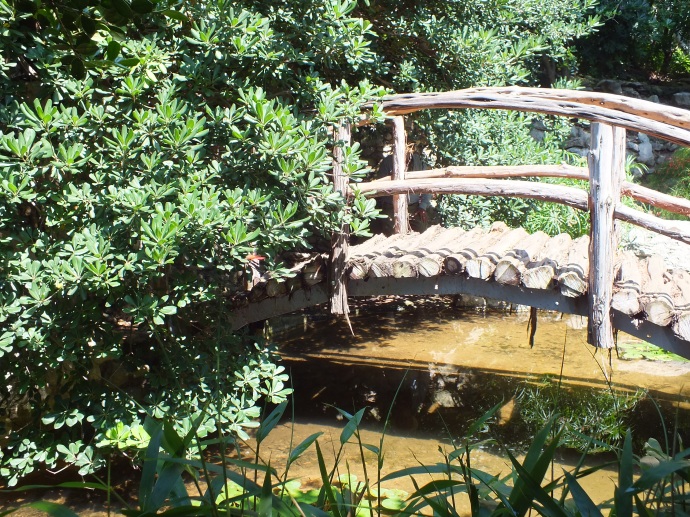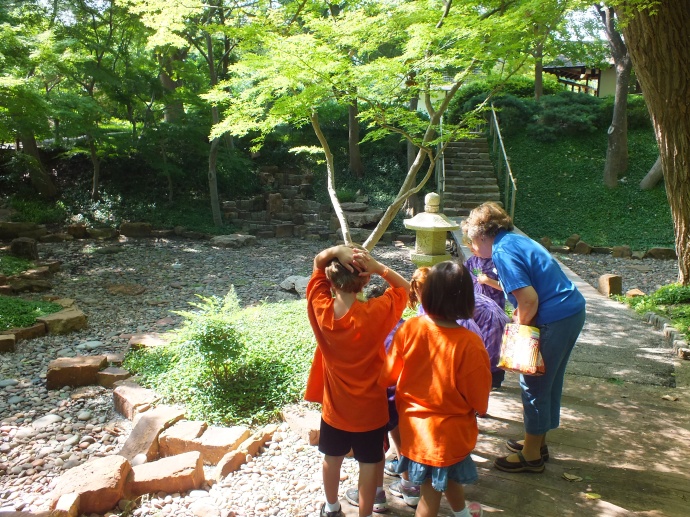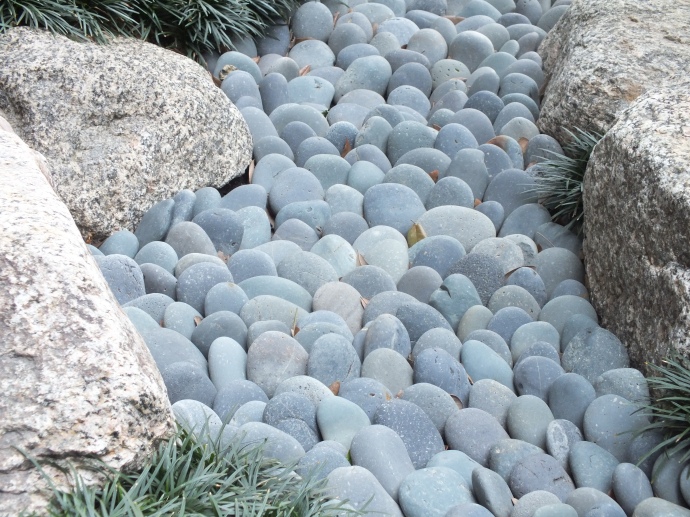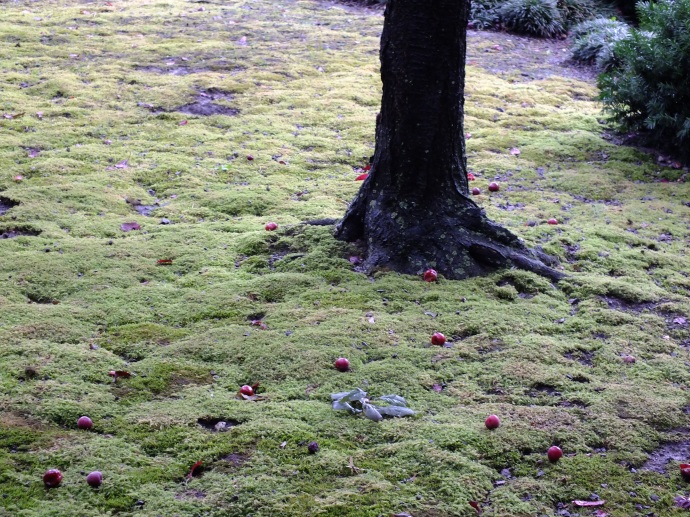The Japanese Garden at the Fort Worth Botanic Garden is worth a return visit, in my opinion, every season of the year. Every season has its joys. The variety of plantings and styles of Japanese garden at Fort Worth offer that special kind of joy to all.
I visited two years ago in the spring, took 100 photos in an hour’s time, and have been mentioning it to my husband ever since. Our recent visit this summer, his first, entranced him as much as my first visit did me.
This seven and a half acre site was a watering hole for cattle, a gravel pit, a dump, and a squatters’ camp before Scott Fikes, former Botanic Garden director, and Charles Campbell, former director of Park and Recreation came up with and pursued the idea in the late 1960s. Kingsley Wu, a graduate of the University of Tokyo, was commissioned to finalize plans, according to a garden brochure, and construction began in 1970. After many clubs, companies and individuals put in their time, talent and treasure, the garden opened in 1973.
The resulting collection of gardens offers a pleasant stroll from the main gate through the free courtyard garden to the ticket office to the green and cool delights beyond.

- The main gate was designed by Albert S. Komatsu and dedicated to Scott Fikes in 1976. The gift shop is off to the left.
(photo by Bill F. Eger)
A little history on the early designers
The main gate was designed by Albert Komatsu and Associates, an architectural firm founded in 1959 and later known as Komatsu Architecture. Alfred Komatsu was a well known, award-winning and highly respected architect in Fort Worth. He helped found the Society of American Military Engineers post in Fort Worth (SAME) and in 2011 was its oldest living founder.
The main gate was dedicated to Scott Fikes in 1976. Fikes retired in 1975 after serving 17 years as the Fort Worth Botanical Garden’s director. He served in the U.S. Army in World War II and was a member of the National Society of Landscape Architects. He passed away in 2002.
Charles Boyle Campbell was a landscape architect by training. He was 39 years old when he accepted the position in Fort Worth as director of parks in 1962. Two years later, the parks and recreation boards were merged and Campbell was named director of the new department.
“Throughout his quarter-century of service, he was a strong advocate for the creation of green space, and during his tenure, city regulations were amended to require residential developers to set aside parkland in their subdivisions. During the years he served as director, the number of parks increased from 57 parks on 2,872 acres to 163 parks with 9,923 acres,” said Susan Allen Kline in the book Images of America: Fort Worth Parks. Campbell retired in 1987 and passed away in 2006.
Steve Huddleston remarked on Kingsley Wu on the occasion of the 75th anniversary of the Fort Worth Botanic Garden: “The major project in the garden during the late ‘60s and early ‘70s was the construction of the Japanese Garden, a 7.5-acre garden that is now the crown jewel of the Fort Worth Botanic Garden. In 1968, the city employed Kingsley Wu, professor of environmental living at Texas Women’s University, to design a master plan for the Japanese Garden. The three major pools were staked and then 454 cubic yards of concrete were poured to line the pools. A waterfall, spillways, and islands were fashioned in and around the pools. Patterned after the Ryoan-ji in Kyoto, the meditation garden was built in 1970.”

a school group enjoys the classic karesansui
(photo by Bill F. Eger)
Among new plantings this spring are cherry trees, the gift of the Japanese Embassy to mark the centennial of Tokyo’s gift to the United States of more than 3,000 cherry trees planted at the Tidal Basin in Washington, D.C.
“The most reliable and readily available variety of flowering cherry is the ‘Kwanzan’ (Prunus serrulata ‘Kwanzan’),” says Scott Brooks, senior gardener at FWBG. He oversees the 7 ½ acre Japanese Garden there. “It’s capable of reaching 25 feet in height with branches that start out upright and then spread horizontally. It has 2-inch-wide, rose-pink flower clusters. Newly planted trees produce a good showing of flowers, although bloom improves as the trees mature.”
Another variety that does well here, Brooks says, is Yoshino (Prunus x yedoensis), the variety Japan gave to the United States in 1912. It’s a fast-growing tree that can reach more than 30 feet. Although the young trees do not produce a lot of flowers, mature trees bloom profusely.

Springtime crabapple bloom with new maple leaves near the pavilion in 2010
Brooks came to the garden in 1982 as a groundskeeper. By then many of the original trees had matured. The garden was clotted with vines and undergrowth. Tunnels had formed where the original designers had created paths.
Brooks set about the hard work of carefully uncovering what Fikes, Campbell, Komatsu and Wu had created, traveling several times to Japan. There gardeners steeped in 1,500 years of tradition taught him: “If you’re the keeper of a Japanese garden, you need to think about removing something every year,” he said.

dry stream
(photo by Bill F. Eger)
Brooks now is the senior gardener. He showed us through, with that ever watchful gardener’s eye for something amiss or out of place, and spoke of the delights and challenges of this ever changing scene.
Sister City
Nagaoka and Fort Worth have an active and dynamic Sister City relationship, celebrating 25 years this year in October. Mayor Betsy Price and Councilman Danny Scarth will lead a delegation to Nagaoka, Japan, to join in their fall festival October 2 to 12.
In the 1990s, Nagaoka, donated an authentic Mikoshi (a gilded and lacquered palanquin) to Fort Worth, which is currently on display within the Mikoshi House. Several trees, including pines and flowering cherries, were similarly donated.

Mikoshi — a gift of Sister City Nagaoka

view out the door of Mikoshi House

Mikoshi House in the spring of 2010
In 1997, Mr. Shigeichi Suzuki, a landscape architect from Nagaoka, donated plans for a karesansui-style addition to the garden.
“When I received the plans, they were in kanji and metric,” said Brooks chuckling. “That was a wonderful challenge figuring that out.”
The addition was completed in 2000, and is now called the Suzuki Garden. It is a modern counterpart to the nearby classic karesansui of the same design as the abbot’s quarters of Ryoanji in Kyoto.

Suzuki Garden
(photo by Bill F. Eger)
The tea house at the end of the pond was built as a memorial to the late Mary K. Umstead, secretary to the Horticulture Division. It was rebuilt this past year using plantation-grown ipe as a more lasting, sustainable tropical hardwood.

Mary K. Umstead Tea House, rebuilt in the past year
A new barrier free approach to the pavilion area offers visitors a closer view of the main waterfall. The Shinto-esque pavilion area offers several structures available for rental for special celebrations and weddings.

new waterfall view
(photo by Bill F. Eger)

Behind the pavilion area, a small staircase leads to a plaza. Out of view to the right is barrier free access to the same area.
(photo by Bill F. Eger)

moon-viewing platform and amphitheatre
(photo by Bill F. Eger)
“The ‘Moon-Viewing Deck’ is a creative adaptation of the Ginkakuji temple’s famous ‘Kogetsudai’ sand cone. Fort Worth’s version is intended to be an interactive karesansui exhibit, in which visitors may ascend the flat-topped cone via steps, and view the composition from above. A ‘Taijitu’ (a yin-yang symbol), lies embossed in exposed-aggregate concrete at the summit. This highly unusual (but fun) addition to a Japanese garden is ultimately a cosmological symbol of Chinese origin. It also has other interpretations, including its most important contemporary association with Korean culture, and as a metaphor for oriental mysticism in American ‘Pop’ culture. The exhibit also features an amphitheatre that is countersunk into the same platform as the cone. Together, they serve as a performance venue for the garden’s two annual festivals (matsuri), and as a moonlit chapel for weddings,” Brooks said


Paths
In all, there are nearly 6,000 linear feet of stone, brick, wood, aggregate concrete and asphalt walkways in the garden, three pools and a couple of waterfalls including a small one in the corner of the entry to the gift shop, seven crossings over water, multiple fish food dispensers, an abundance of healthy koi in the ponds and plants to occupy the eye and mind.

gift shop in the spring of 2010

gift shop in the summer 2012 — note the impact of recent drought on the pond water level
(photo by Bill F. Eger)
Treasure Tree gift shop occupies a waterside structure reminiscent of medieval Japanese architecture. The well stocked store is operated by the Fort Worth Botanical Society. Proceeds benefit the continuing development and preservation of the garden.
The garden is included in the Fort Worth Botanic Garden web site http://fwbg.org/gardens/japanese/ and maintains its own Facebook page http://www.facebook.com/pages/Fort-Worth-Japanese-Garden/168365139854742 on which Brooks has included several detailed guides to the plantings in multiple scrapbooks.
Operating hours during standard time are 9 a.m. to 5 p.m. daily and during daylight saving time 9 a.m. to 7 p.m. daily except Christmas. Admission fee for adults is $4.50 on weekends or $4 on weekdays; $3 for children ages 4 to 12. Children ages 3 and under are admitted free. Unsponsored children under 13 are not admitted. One adult may sponsor 5 children.
For additional information, call (817) 871-7686.

enticing benches
(photo by Bill F. Eger)
Photos with no credit line in this blog are by K.T. Cannon-Eger. Click on any image to see it full size.
Several videos of the Fort Worth Japanese Garden are featured on YouTube. Here is a short one from the spring festival http://www.youtube.com/watch?v=Xqj2KIb-DQs
and a longer piece featuring spring blooms
http://www.youtube.com/watch?v=4FWsA2UCqUY
another featuring a summertime stroll with emphasis on the koi http://www.youtube.com/watch?v=j_ysysau35U
a taiko performance of Ujigawa by Dondoko Daiko at the 2009 fall festival http://www.youtube.com/watch?v=upJ-5udVI4s
and one longer narration from winter http://www.youtube.com/watch?v=0dZCKCbo378

A personal note:
There’s something really wonderful about garden friends: you speak the same language, share similar goals, and in the best of times have the same taste in movies and jokes. Scott Brooks is one of those wonderful garden friends.
We met briefly in Long Beach, California, in spring of 2009 at the International Conference on Japanese Gardens Outside Japan. A year later, I stopped off in the Dallas-Fort Worth area on my way home from my mother’s death in Florida. My cousin dropped me off at the garden gate and I began my wandering in a somber mood.
Pretty soon, I was engaged by the collection of gardens – entranced by proportions, variety and trimming of various plantings.

Scott Brooks at work in 2010
As I wandered down the right side of the garden, I noticed maintenance going on at the left side of the pond. I kept catching glimpses of this man in a black t-shirt pushing a wheelbarrow. When I finally came even with him, I asked the perennial gardener’s question, “What are you working on?” “Re-doing the water pipe to this basin,” he replied “Have you been here long?” I asked. “28 years since 1982.” “Say, you look familiar….” and when we got to Long Beach as common ground he exclaimed, “You’re that lady from Hawaii.”

forsythia near the pag
Later, as I approached the end of the path to meet up with my cousin at the gift shop, there was a splash of yellow by the pagoda – forsythia, one of my mother’s springtime favorites.
The Long Beach conference not only formed fast friendships, it led to the formation of the North American Japanese Garden Association (NAJGA). Fort Worth hosted one of the regional meetings that led the group from initiative to association.
The organization hosts a web site http://www.najga.org/cfm/index.cfm and a Facebook page. NAJGA will host Connections 2012, a conference for garden professionals and enthusiasts in Denver, Colorado, October 12 through 14 with a one-day advance design workshop on October 11. The conference is geared toward three topics every garden deals with: horticulture, human culture and business culture. Contact NAJGA for further information and to register.

pagoda designed by Albert Komatsu
(photo by Bill F. Eger)








